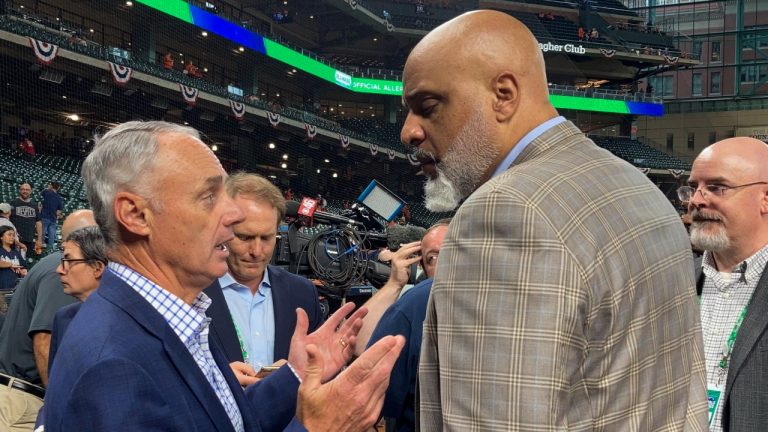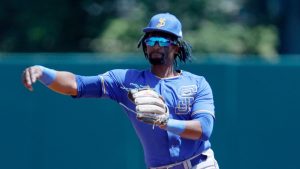TORONTO – Major League Baseball made a jarring transition from billion-plus dollar free-agent frenzy to lockout, starting the sport’s first labour interruption since the 1994 strike immediately after the collective bargaining agreement’s expiration as Wednesday became Thursday.
That the sides are going down this path is no surprise, as three days of discussions in Dallas failed to avert what one player source briefed on discussions said had long felt inevitable, given the scope of disagreement on core economic issues.
He expressed hoped the negotiations wouldn’t devolve into angry public sniping the way it did before the pandemic-shortened 2020 season, damaging an industry facing worrying headwinds and in need of ways to engage younger fans.
Instead, the public-relations fight began nearly as quickly as the lockout was implemented, with commissioner Rob Manfred describing the decision in a letter to fans as a “defensive” manoeuvre needed “because the Players Association’s vision for Major League Baseball would threaten the ability of most teams to be competitive.”
The players association responded by calling the lockout an owners’ choice “specifically calculated to pressure players into relinquishing rights and benefits, and abandoning good faith bargaining proposals that will benefit not just players, but the game and industry as a whole.”
Statement from the Major League Baseball Players Association: pic.twitter.com/34uIGf762W
— MLBPA Communications (@MLBPA_News) December 2, 2021
A head-spinning run of transactions in recent days made for a bizarre segue back into the labour troubles owners and players faced from 1972 through 1994-95, when there were eight work stoppages (five strikes, three lockouts).
No. 8 was the players strike that killed the ’94 World Series and sent the Montreal Expos into a death spiral, but ushered in 26 uninterrupted years, even as they came to the brink during negotiations in 2002 and 2016.
Manfred, in public comments after owners’ meetings last month, pointed to the 1994 strike as a strategic error on MLB’s part and argued that “an off-season lockout that moves the process forward is different than a labor dispute that costs games.”
Later, he added, that, “I think when you look at other sports, the pattern has become to control the timing of the labour dispute and try to minimize the prospect of actual disruption of the season. That’s what it’s about: It’s avoiding doing damage to the season.”
The concern now is that in absence of a deadline, there will be no pressure-points to move negotiations forward until reporting dates for spring training near, and there hasn’t been this wide a chasm between the parties since the 1994 strike, when owners were intent on getting a salary cap.
The union feels the subsequent negotiations progressively added small changes that have added up to something akin to a loose cap that artificially restrains salaries. Owners, after all, can play a long game over decades that players, with their much more finite careers, cannot.
Still, it’s a concern for the sport as a whole that every single World Series game this year was outdrawn by regular-season NFL contests in American TV ratings, and that baseball’s fanbase is largely aging.
Each has different solutions – stop tanking and restore competition, say players; become stakeholders and grow your share of revenue, say owners – and there are those on both sides who believe the sport’s compensatory structure needs updating to reflect evolutions in how the game is played, managed and evaluated.
The spasm of activity in recent days can be viewed either as a reflection that owners and players envision an eventual return along relatively similar lines, or as a rush to lock deals in place before an uncertain world of change arrives.
Manfred, in his letter, pointed to the “$1.7 billion committed to free agents, smashing the prior record by nearly 4x” as proof the system isn’t as broken as players claim and blamed the union for coming “to the bargaining table with a strategy of confrontation over compromise.”
In a brief statement, Tony Clark, the union’s executive director, called the lockout a “drastic and unnecessary measure” that “will not affect the Players’ resolve to reach a fair contract. We remain committed to negotiating a new collective bargaining agreement that enhances competition, improves the product for our fans, and advances the rights and benefits of our membership.”
As the rhetoric picks up, this piece of perspective is worth keeping in mind:
If a #lockout occurs keep in mind there are 3 sides to every story. Unless you're in the room, you won't know the facts. Reasons for could vary: owners vs players; owners vs owners; owners testing new generation of players; players holding fast to $ demands, etc.
To be cont. https://t.co/Dav6SSymjq
— Greg Bouris (@bourisg) December 1, 2021
Either way, there are several key points of dispute, and here’s a look at them based on conversations with executives, players and agents:
[snippet id=5247941]
Incentivizing Competition
WHO’S DRIVING THE ISSUE: Players
WHY IT MATTERS: This has been a frequent talking point for super-agent Scott Boras in recent years, but he’s far from alone in worrying about the scourge of tanking in the sport. The union’s belief is that the revenue-sharing system implemented between clubs in the CBA agreed to in the summer of 2002 is partly responsible for this, moving around enough money to protect clubs from the economic consequences of losing seasons. Then, the draft’s signing bonus pool system implemented as part of the CBA agreed to after the 2011 season amplified the motivation for teams to tank, as the lower a team finished, the more bonus pool room they would have in the next year’s draft. Teams like the Chicago Cubs and Houston Astros really weaponized this trend and now you have abominations like the Baltimore Orioles totally punting on major-league calibre talent while trying to build a critical mass of young prospects. Fewer teams competing for players has drastically impacted the free-agent market in recent years, too, particularly in the lower middle class, and correcting this is a key union goal.
POSSIBLE SOLUTIONS: Owners have suggested a spending floor for teams, although that came with a lower competitive balance tax threshold as well — a non-starter. A draft lottery is another idea, as is rewarding teams that just miss the playoffs with extra draft picks. Strengthening the existing stipulations on spending proceeds of revenue sharing for receiving teams is another workaround, while more radical would be reworking a system initially designed to help smaller markets compete.
Linking Salaries to Revenues
WHO’S DRIVING THE ISSUE: Owners
WHY IT MATTERS: This has long been the dream for owners, enough so that they were willing to cancel the ’94 World Series and enact a cockamamie replacement-player scheme the following spring. It took a federal court ruling that owners had bargained in bad faith to get the game going again. A mild luxury tax was implemented in 1997 and eventually led to the competitive balance tax, or CBT, being put in place in 2002. That worked well enough but MLB started floating the idea of a link between salaries and revenues back in 2019 as a way to counter player concerns about spending. The pitch is that as revenues in the sport grow, so too do salaries. The players have always pushed for as free a market as possible, so the idea is anathema. But with owners concerned about the future of regional-sports-network revenue and gambling remaining an uncertain stream to counter that, there’s interest in some type of mechanism with direct link.
POSSIBLE SOLUTIONS: This is such a monumental reworking of the sport’s economic system it would likely require something akin to the NHL lockout of 2004-05, when an entire season was lost, to accomplish it. At its core, the issue is how to distribute the game’s revenues, with owners trying to keep the current split static and players trying to get more of the pie.
Getting Players Paid Earlier
WHO’S DRIVING THE ISSUE: Players
WHY IT MATTERS: While this is definitely a union priority, there’s some desire to address this on the ownership side, too. The way the game works, players with 0-3 years of service time earn something near the major-league minimum, players with 3-6 years of service time are able to accelerate their salaries through arbitration and 6-plus players can become free agents. Amid a youth movement within the game, 0-3 players are creating more value on the field and not being properly compensated for it. Consider that AL MVP runner-up Vladimir Guerrero Jr., made $605,400 as a 1-plus service time player for the Toronto Blue Jays in 2021, less than the $650,000 fringe outfielder Brian O’Grady was given by the San Diego Padres after he was released by the Tampa Bay Rays. As a result, good young players are the best bargain in baseball and as teams have more effectively modelled out performance aging curves, fewer players are making up the lost surplus they provide earlier in their career once/if they get to free agency. That’s become a real friction point and ultimately, doesn’t make much sense for the game.
POSSIBLE SOLUTIONS: This isn’t easily resolved without completely upending the game’s reserve system. The players have proposed starting arbitration earlier for players while owners proposed replacing arbitration with a system settling club-control-years salaries through Fangraphs’ WAR calculations, along with making 29½ the age threshold for free agency. While those ideas won’t fly with the union, it’s an example of the type of creative thinking called for.
Expanded Post-Season
News from @JesseRogersESPN: In a proposed playoff expansion, there would be 14 teams, division winners would choose their opponents in a three-game wild-card round and the best record in the league would get a bye into the division series. Much more info: https://t.co/YivuoSlyyz
— Jeff Passan (@JeffPassan) November 29, 2021
WHO’S DRIVING THE ISSUE: Owners
WHY IT MATTERS: This is a big revenue driver for owners and was used to help counter some of the lost revenue from the fan-less 2020 season. They wanted it again in 2021 but players balked, concerned that a lower barrier-to-entry would decrease the motivation of teams to spend on talent. Still, as a way to grow the game and extend interest across a wider array of markets, there’s certainly merit to this idea, especially as the sport works to lure in younger audiences.
POSSIBLE SOLUTIONS: This certainly seems like a piece players will trade during negotiations for concessions somewhere else, part of a more holistic suite of changes in the agreement.
Service-Time Manipulation
WHO’S DRIVING THE ISSUE: Players
WHY IT MATTERS: In a highly competitive sport, logic dictates that a team always rosters its best players but a neat trick teams discovered is that by holding back a top prospect’s arrival by a few weeks, they could delay a player’s free agency by an entire season. That’s smart business and it’s why teams did this regularly, prompting a grievance over Kris Bryant’s delayed arrival with the Chicago Cubs in 2015. An arbitrator ruled that the Cubs complied with the CBA, which was true technically, but not in spirit. Ultimately, a player’s promotion should be dictated by his readiness and team need, rather than by the ability to control his service-time clock. That’s in the interest of both sides, but the economic incentive is too high for clubs right now.
POSSIBLE SOLUTIONS: Solving for this is incredibly complex because there may be times that a team legitimately feels a player isn’t ready for promotion to the majors, and sometimes there’s a just baseball case for more development time. This is where the owners’ proposal of free agency at 29½ comes in, but with the best players reaching the majors younger and younger, this would actually delay their entrance into the free market. Take Guerrero as an example. He debuted at age 20 and under the current rules, would be a free agent after the 2025 season. Under the proposal, he’d hit the market after the 2028 campaign. Non-starter. But the concept of a firm end point for a club’s control over a player dictated by years spent in the system as opposed to service time could offer a logical framework.
Rule Changes
WHO’S DRIVING THE ISSUE: Owners
WHY IT MATTERS: Even people who fully love baseball think the game has gotten too long, too static, too one dimensional, and owners see rule tweaks as a way to engage a younger audience. You’ve heard some of the ideas — a pitch clock, universal DH, no infield shifts, etc. — and there have been trials for many of them in the minor-leagues. During the All-Star Game in July, commissioner Rob Manfred said he was seeking agreement with the union on “non-radical changes to the game that will restore it to being played in a way that is closer to what many of us enjoyed historically.” Players want a say, obviously, since banning shifts, for instance, will work for hitters and against pitchers, affecting the compensation for both. Still, finding common-ground on adjustments to make the game more enjoyable is in the interest of both sides, as growing the game’s appeal is mutually beneficial.
POSSIBLE SOLUTIONS: Count this one in the pieces to be traded during negotiations category.
Artificial Salary Restraints
WHO’S DRIVING THE ISSUE: Players
WHY IT MATTERS: Be it the $210 million CBT threshold that to a degree has served as a de facto salary cap or the loss of a draft pick attached to the signing of qualified free agents, the union believes certain restrictions in the economic system are used by teams to justify not spending and unfairly drag player compensation. Without doubt traditional big spenders like the New York Yankees have made efforts in recent years to avoid the penalties for venturing past the CBT line as consecutive years of exceeding the threshold causes the tax rates a team pays to rise (it’s 20 per cent on overage the first time, and rises up to 50 per cent). There’s also a 12-per-cent surtax for going $20-40 million over the line, rising to 42.5 per cent on excesses beyond $40 million along with losing 10 spots on the highest selection in the next draft. Meanwhile, teams tend to deduct the value of the compensatory draft pick they must surrender to sign a qualified free agent from their offers to a player, and some teams have avoided free agents because of the draft-pick penalty.
POSSIBLE SOLUTIONS: Players want to see the CBT threshold increased while owners do not, so if it remains in the next CBA, someone will have to give. Compensatory draft pick rules have been adjusted the past two agreements to try and soften the impact and lessening the quality of draft pick surrendered would further help in that regard.
International Draft
WHO’S DRIVING THE ISSUE: Owners
WHY IT MATTERS: The league has long wanted a more structured framework to more fairly distribute international talent, leading to the idea of an international draft akin to the annual June draft for North American high school and collegiate players. Strict international spending pools were implemented instead as the mechanisms of such a draft have proved too burdensome to overcome. There’s also resistance to the idea from international players, who don’t want to surrender the open-market controls they currently hold in the process.
POSSIBLE SOLUTIONS: Tweaking international bonus pools may be one way to strike a balance here with player resistance to a draft idea that may be too logistically challenging.
[relatedlinks]






COMMENTS
When submitting content, please abide by our submission guidelines, and avoid posting profanity, personal attacks or harassment. Should you violate our submissions guidelines, we reserve the right to remove your comments and block your account. Sportsnet reserves the right to close a story’s comment section at any time.